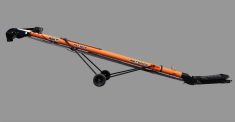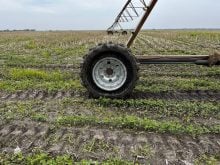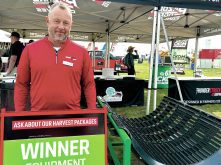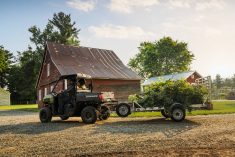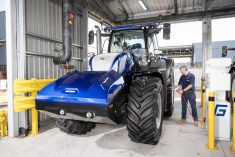For many of us, winter is a season of feeding cows. Feed is one of the key drivers of animal performance and is one of the highest direct costs for most cattle operations.
Notice the use of the word feed. Feeding — that is, the act of providing feed — can also be one of the highest costs for an operation. In some cases, it may be higher than the actual cost of the feed.
To create a reasonably clear division, a good rule of thumb is that all the expenses going into the feed stack/bin are a feed cost. Yardage would refer to those costs on the other side of that feed stack that are not feed. This set would include corrals and repairs, waterers and electricity, feeding equipment, corral cleaning, fuel and labour. I like thinking about the concept of yardage, as it puts into perspective our operational choices and their impact on our bottom line. A couple of simple examples showcase some of the impacts of our choices and provide some food for thought.
Read Also

Claas brings 1000 Series SP forage harvesters to Canada
In mid-August, Claas unveiled its new line of Jaguar forage harvesters at an event in Visalia, California, deep in the heart of that state’s dairy region.
Let’s consider feeding with a loader tractor. For this example, I used the Saskatchewan Custom Rate Guide for a front wheel assist tractor up to 160 horsepower. This represents a typical chore tractor in a lot of the country. Rental rates are listed from $55.40 to $108.37 per hour. The rate is higher the more horsepower we have. Custom work (which includes labour, fuel and repairs) is listed from $124.36 to $209.41 per hour. Whether you agree with these costs or not, it will serve to demonstrate the point.
If we feed 100 cows with our tractor and it takes one hour per day, at the lowest custom rate guide cost, we have $1.24 per cow/per day in yardage for the tractor and labour. If we can feed 200 cows in that same time frame (one hour per day) our yardage cost is now half, or 62 cents per head per day. This demonstrates the importance of efficiency in the feeding operation.
It also demonstrates that yardage costs can add up in a hurry. In this example, if we fed 100 cows for a 200-day winter, we have $250 per cow tied up in just our tractor and labour costs. There may be other ways to use that tractor that are more efficient and can result in significant savings.
The same rule of scale applies to facilities. If we invest $20,000 in corrals, spend $1,000 per year on repairs and plan a 20-year life span, a simple division puts us at roughly $2,000 per year. If we use the corral for our 100 cows for 100 days per year, the yardage cost is 20 cents per head per day. If the same facility can be used for more animals or over more days, the yardage cost of facilities is reduced. If a facility can be built with a longer lifespan — for example, putting an electric wire inside slab corrals — we may also be able to reduce yardage costs.
Knowing your own yardage costs is a valuable piece of management knowledge, but these two simple examples expose an interesting catch-22, particularly for those of us who use extended grazing systems. By feeding more cattle or feeding for longer, some yardage costs, such as facilities, may be reduced, particularly on a per-head per-day basis.
Conversely, by feeding longer, some yardage costs may be increased, such as labour, machinery or corral-cleaning expenses. This exposes one of the largest weaknesses in the way we think about yardage and why considering overhead costs may be more impactful.
Let’s look back at our tractor example. By not putting our 100 cows into a confined feeding situation, we can save on yardage; however, if we still own the tractor — just choosing not to use it — our savings are not the entire $1.24 per day. We still have an overhead cost for the tractor. That cost may be significantly lower than feeding daily with the tractor, but is still a cost.
Even with extended grazing systems, if our yard remains a parking lot for feeding equipment, we will have an overhead cost for that equipment. Not all yardage costs are bad. Some yardage costs may be a good thing. A good water supply may have a yardage cost, but can positively impact performance, or an investment in feeders/troughs and feed delivery is a yardage cost, but may be rapidly offset by feed savings.
Three key points to remember about yardage are:
- Your yardage cost is probably higher than you think, and you need to run your own numbers.
- We fight yardage costs; we need to be as efficient as possible. This may include feeding more cattle, feeding faster or improving cattle performance.
- Reducing yardage is not the same thing as reducing overheads, although it can be.
There is nothing inherently wrong with feeding cattle or having yardage costs. The activity of providing feed and support for cattle can provide value to the operation. In some situations, folks just like feeding cattle and yardage is a secondary consideration to personal enjoyment. In other cases, adding yardage costs such as facilities is required for safety, efficiency, and quality of life. That said, yardage costs can be a significant drain on profitability of a beef cattle operation and perhaps more importantly simply tackling yardage costs may not eliminate overhead costs to the operation.

While every operation will have a different set of resources and thus a different feeding solution, knowing your yardage costs is vital to create a profitable beef cattle enterprise.



